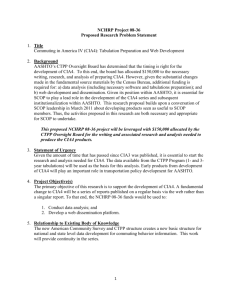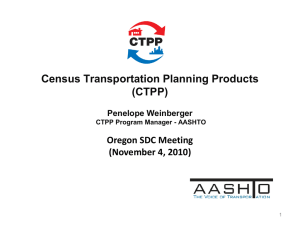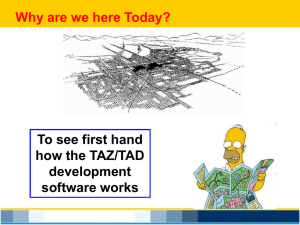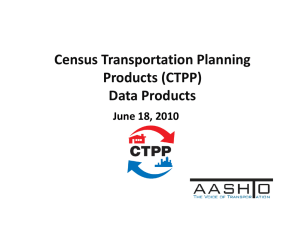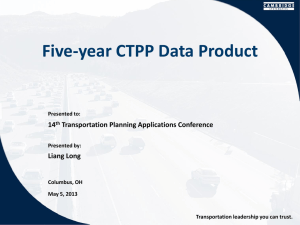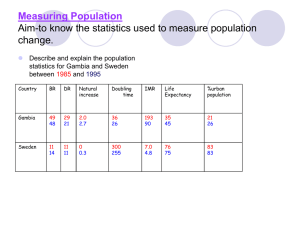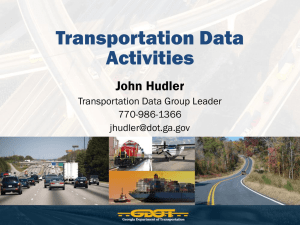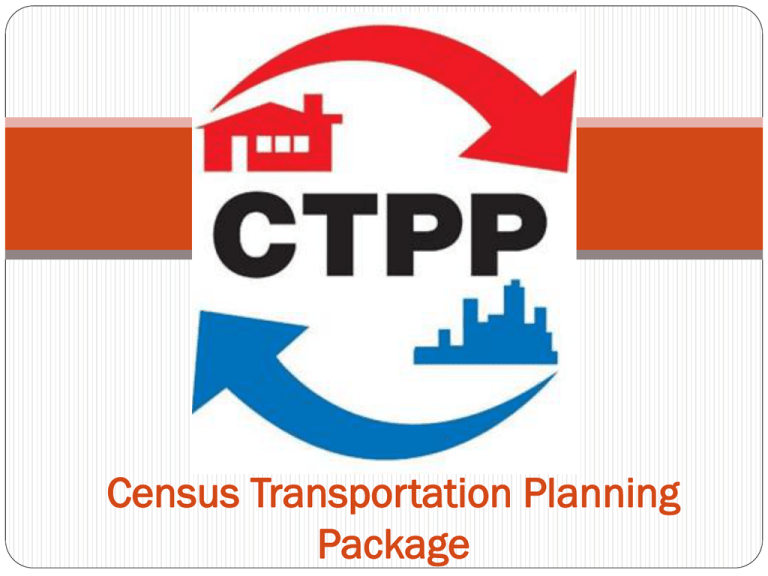
Census Transportation Planning
Package
Mid-Region Council of Governments
A Little bit about MRCOG
NM Rail
Runner
Express
Workforce
Connection
Of Central
New Mexico
(WCCNM)
Local
Planning
Assistance
Metropolitan
Planning
Organization
(MPO)
MRCOG
Agribusiness
(EDA)
Rural
Transportation
Planning
Organization
(RTPO)
Regional
Transit
District
(Rio Metro)
Economic
Development
District
A Little bit about YOU
Agenda
CTPP Basics
What’s New with the CTPP?
CTPP Parts and Tables
CTPP software and online data access
CTPP Resources
What is the CTPP?
A Partnership effort between MPOs, DOT, FTA, FHWA,
AASHTO, TRB and the Census Bureau.
Set of special tabulations collected by the US Census
Bureau.
Designed by Transportation Planners for the purposes of
Transportation Planning.
What Makes CTPP Unique?
Tabulations at
Residence
Part 1
Tabulations at
Workplace
Part 2
Flows between Home
and Work
Part 3
Variables Available
TRANSPORTATION
SOCIOECONOMIC
Place of Work
Minority Status
Means of Transportation
Age of Worker
Workers per Vehicle
Sex of Worker
Time Leaving Home
Household Income
Travel Time
Poverty Status
Vehicles Available
Occupation & Industry
Class of Worker
*Variety of Cross-tabulations available
Potential Applications
Transportation planning:
How many people commute from Belen to Albuquerque?
What are some key employment destinations that may be appropriate for TOD?
Travel Model Validation & Sample Design for travel surveys
Employment Analyses:
What are the most common destinations for work commuters?
How do centers compare in terms of worker earnings, ages, industries?
Targeted Analyses:
How many workers work at home & in which industries?
How is mode choice impacted by race? Age? Income? Vehicle Availability
Generate Statistics:
What is the average number of workers per vehicle?
How many workers are there per household?
Data Products
Decennial Census Journey-to-Work Data
2000, 1990, 1980, 1970, 1960
Transportation Profiles, 2000 (State & County)
American Community Survey Journey-to-Work Data
Characteristics & Flows, 2006 - 2008 (20,000+)
Transportation Profiles, 2005, 2005-2007, 2006-2010
Characteristics & Flows, 2006 – 2010 (All Geographies!)
Decennial Census vs. ACS:
Survey Implementation
Frequency
Every 10 years vs. Continuous
Sample Size
1 in 6 hhlds vs. 1 in 40/yr
Follow up
100% follow up vs. ½ to ¼
Workers
Temporary vs. full-time workers
American Community Survey
& CTPP Releases
Data
Product
1-Year
Estimates
3-Year
Estimates
5-Year
Estimates
Data
released in:
Population
Geographic
Threshold
Options
2006
2007
2008
2009
2010
2011
2012
2013
65,000+
State, County,
Place, PUMA
2005
2006
2007
2008
2009
2010
2011
2012
2005- 20062007 2008
20072009
20082010
20092011
20102012
20052009
20062010
20072011
20082012
20,000+
Plus UA’s
All Areas*
Plus Tracts &
Block Groups
Worker
Flows
12
Non-Disclosure Rules
US Code Title 13, Section 9 ensures that no published data can
disclose an establishment’s or individual’s identity
Rule #7:Worker flows must have 3 un-weighted cases for each O-D pair
CTPP 2000: 82 percent of tract-to-tract data & 89 percent TAZ-to-
TAZ flow data were suppressed
ACS 5-yr sample: about 50 percent of Census 2000 ensuring almost
no flow data at TAZ or Tract level using suppression rules
CTPP 2006 – 2010 uses data perturbation techniques & iterative
proportional fitting, along with rounding and grouping methods
Two Sets of Tables
Set A: Non-Disclosure proofed microdata
Rounding, cell & table suppression
Set B: Disclosure proofed microdata
data perturbation methods applied, suppression rules lifted
When using both, row and column totals won’t match for the
same population and geographies
NCHRP 08-79
Producing Transportation Data Products from the ACS
that Comply With Disclosure Rules
http://onlinepubs.trb.org/onlinepubs/nchrp/nchrp_w180.pdf
Variable Groupings
Rounding Rules
Zero = 0
1–7=4
8+ = nearest 5th
Mode to Work
Total
Drive Alone
Carpool
Transit
Walk
Bike
Value
352
212
46
59
33
2
Rounding
350 (not 355!)
210
45
60
35
4
Geography Available
Residence & Workplace Geography
Nation (US Total)
State**
State-County
State-County-MCD (for 12 MCD states)
State-Place
State-PUMA5
Metropolitan Statistical Area
Urbanized Area (Residence Only)
State-County-Tract
TAD
TAZ
What is a TAZ?
Transportation Analysis Zone
Delineation process led by MPO’s
In general, population is 1,200 or greater
Must nest within counties & TAD’s
http://www.census.gov/geo/maps-data/data/tiger.html
What is a TAD?
Transportation Analysis District
Delineation process led by MPO’s
Population must be greater than 20,000
No nesting criteria, must be composed of whole TAZ’s.
http://www.census.gov/geo/maps-data/data/tiger.html
FROM Residence Geography
State
Flow Geography
TO Workplace Geography
State
State-County
State-County
State-County-MCD (for 12 strong MCD states)
State-MCD (for 12 strong MCD states)
State-Place
State-Place
Metropolitan Statistical Area – EACH Principal
City
State-County
Metropolitan Statistical Area – EACH Principal
City
State-Place
State-County-MCD (for 12 strong MCD states)
State-Place
State-PUMA5
State-Place
PUMA5
POWPUMA
Tract
Tract
TAD
TAD
TAZ (Base)
TAZ (Base)
TAD
TAZ (Base)
TAZ (Base)
TAD
State-Place
TAZ (Base)
TAZ (Base)
Place
Tables Available
Part 1
200 T a b l e s
(at Residence)
Part 2
115 T a b l e s
(at Workplace)
Part 3
(Worker Flows)
39 T a b l e s
Let’s look at the Table List
Accessing the Tutorial Manual
Software Tutorial Manual
http://ctpp.transportation.org/Documents/CTPP_tutorial_v02.pdf
Accessing the Web-based Training
Web-Based Software Training
http://www.youtube.com/user/CTPPProgram
Accessing the Data
CTPP Software Demonstration
http://ctpp.transportation.org/Pages/5-Year-Data.aspx
Limitations
Universe is often Workers only, 16 and over (no retirees, students,
unemployed)
Work Commutes only (no shopping, school trips, medical, etc.)
Census Geography. No address point data (OnTheMap)
Data suppression, rounding, grouping, synthesis
Those darn ACS margins of error!
A word of caution
CTPP 2006 – 2010 does not currently include workplace data
for TAZs with zero (0) populations. This is being rectified and
a new dataset will be released around January, 2014.
This means that any TAZ which consists solely of a special
generator (i.e., an airport, a shopping mall, a business park etc.)
does not have workplace data or flow to it available.
The data IS available at tract for Tracts with zero (0)
population, so you can do Tract flows.
Resources
AASHTO website
http://ctpp.transportation.org/
FHWA website
http://www.fhwa.dot.gov/planning/census_issues/ctpp/
CTPP List Serve
http://trbcensus.com
“Status Report” newsletter
http://www.fhwa.dot.gov/planning/census_issues/ctpp/status_report/
http://www.trbcensus.com/newsletters.html
E-Learning Modules
http://ctpp.training.transportation.org/
The ACS compass handbooks
A Compass for Understanding
And Using ACS Data
l Set of user-specific handbooks
l Train-the trainer materials
l E-learning ACS Tutorial
l Annotated Presentations
http://www.census.gov/acs/www/guidance_for_data_users/compass_products/
Special CTPP Contacts
Penelope Weinberger
CTPP Program Manager, AASHTO
444 North Capitol Street NE Suite 249
Washington, DC 20001
202-624-3556
pweinberger@aashto.org
http://ctpp.transportation.org
Liang Long
CTPP Technical Support FHWA
202-366-6971
liang.long@dot.gov
Brian McKenzie
CTPP Program Manager
Census Bureau
301-763-2454
Brian.McKenzie@census.gov
Contact Information
Kendra Watkins
Socioeconomic Program Manager
(505) 724-3601
kwatkins@mrcog-nm.gov
Comparison to OnTheMap
CTPP
OnTheMap
Sample survey
Administrative Records
All Workers over 16
Covered Workers any age
Only workers at work during
Omits self-employed,
the reference week
Counts each worker once
TAZ level
Data Synthesis
Detailed Crosstabs
Military & unpaid
Counts each job once
Block Level
Data Synthesis
Limited Socioeconomics

